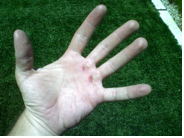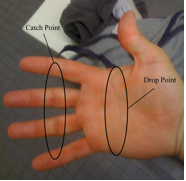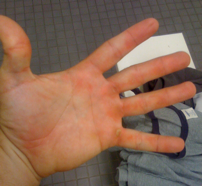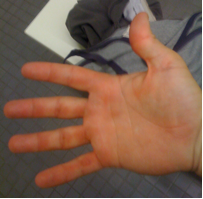How to Change the Game
The Art of Not Tearing Your Hands
Jordan Vezina, RKC
June 24, 2009 07:51 AM
In March of 2008 I was preparing for my first run at the open division of the Tactical Strength Challenge (TSC). One component of the TSC is a five minute snatch set with a 24 kg. kettlebell. Prior to this, I had not really done any high repetition kettlebell snatching. As many of you know, doing a lot of snatches can really tear up your hands. For a while now I've watched people tape up their hands until they look like boxers to prevent tears, or deal with current ones. Other people use gloves or other protective measures, but I prefer the sensation of the handle on my skin. In addition to this, I have small hands, and they are not naturally tough. Quite the opposite, in fact - I am renowned in some parts of the world for my small and ladylike hands. So how was I to train for TSC and the upcoming RKC in August without destroying my mitts?
If you are engaged in a game that you cannot win, do you just keep butting your head against the wall hoping that at some point your skull will become tougher than the wall? No - you change the game.
What causes the tears? The movement of the kettlebell handle across your skin creates friction. This in turn builds up calluses, but it can also tear your flesh, or the calluses. What I had been doing to preserve my hands wasn't working - I had suffered some big hand tears in the past. The photo below will give you a good idea of my hand condition before I decided to try something else.

I decided to try a threefold system:
- Preparation- Making sure my hands were in good shape before the TSC and the RKC, as I would at the beginning of any workout.
- On the spot care- Having the tools on hand that I needed, and taking measures at the proper time to preserve my hands.
- Technique- Modifying the way in which I grip the kettlebell in order to reduce or even eliminate the friction.
It breaks down like this:
1) Preparation
You need to treat your hand care the way you would treat your training, or nutrition. If you let it slide you will pay the price.
Begin with a quick review of the basics of hand care for kettlebell training. You will develop calluses as you train. A common thought among beginners is that calluses are protective, and should be allowed to develop. The problem is that particularly once you move up to the heavier kettlebells, calluses protruding from the hand will catch on the handle and be torn off. To prevent this, we shave the calluses down until they are flush with the hand. This provides protection from blisters, but does not risk the callus being ripped off. Mark Reifkind Master RKC, has recommended soaking the hands for 5-10 minutes in warm water, drying them off, waiting about thirty seconds and then filing the calluses down with a pumice stone or other type of file. This has worked very well for me.
It's important that you file your calluses daily. Even if it's just dusting off the hands for a few seconds, do it every day. Be careful, however, to not dig into your palms and cause abrasions on your skin.
Another essential aspect of preparation is the use of lotion. Cornhusker's Lotion during the day is optimal, as it dries fast and does not leave your hands greasy. It is best to use it several times a day to keep your hands from drying out, and to keep your calluses softer and more flexible. Before bed use a more aggressive lotion, something such as Bert's Bees Hand Repair Cream to really soak into the skin and condition it. Brett Jones, Master RKC, has recommended wearing gloves to bed in order to really get the lotion worked in while you sleep.
2) On the Spot Care
While on the field I kept a bottle of cornhusker's lotion and my stone file in my bag. I would monitor my hands, and whenever I saw some dryness coming on I would dab on some cornhusker's, dry it quickly, chalk up, and get back on the bell. If I didn't have time to let it dry I would dab it off on a towel. During breaks, I washed my hands off (from my water bottle or in the sink) and applied a fresh coat of lotion. You need to get the chalk off your hands before re-applying, otherwise it turns to paste.
During breaks I would take out my file and knock off whatever new calluses were popping up. During lunch and evenings I spent more time on the hands, taking the calluses down and applying more lotion. The lotion is important, as dry skin will crack and tear much more easily than well-hydrated skin. Even just wetting your hands and then drying them off will help if you don't have any lotion.
3) Technique
This is the most important part of this plan. You must alter your technique to ensure you are not creating unnecessary friction, particularly during your ballistic drills.
SwingsSome people have a tendency to really grip the bell hard during swings. This is unnecessary, and you will only be rewarded with torn palms. Grasp the bell firmly to avoid it swinging around in your hands, but do not death grip it. Another part of the swing grip that kills everyone is the outer side of the pinky finger. You will see many people develop big tears in this area. Your pinkies are most likely rubbing against the horns of the handle. To avoid this, make your grip a little more narrow by squeezing your fingers together, or bring your pinkies off the handle completely and point them straight out.
Snatches and CleansThis one is a little trickier, and takes some practice to nail down. I encourage you to put the time into it – if you master this technique you will be able to snatch and clean all day long without tearing your hands.
When most people snatch and clean they allow the handle to rotate through their palm and over the callused pads of their hands. This is the primary culprit in regard to tears. So how do we fix this? Stop rotating it through your palm. Instead, you want to toss the handle from your palm and re-catch the kettlebell in the hook of your fingers. Think of it as sort of like an overhand softball throw. Do not confuse this with casting the bell out; I'm not throwing it out, I'm throwing it down, and I keep my elbow in pretty tight when I do this to shorten the arc.

Many of you will find that effectively doing this will require more grip strength than you currently possess. Something I often hear from people first starting to practice this is that they feel they will miss the handle on the way down, or it will rip from their fingers. Exercises that utilize this same type of hook grip such as pull-ups, farmer's walks, etc. can help to build your grip up.
A great way to practice the drop and catch in the beginning is to practice it from the rack position of the clean. Instead of letting the kettlebell rotate down around the forearm on the way down, pop it over the top and catch it in the hook of the fingers, just like we want to do in the snatch. You can also practice this doing the clean in the traditional manner, popping it out of the palm and re-catching as it rotates around the forearm in the descent.
A side benefit to snatching in this manner is that you are effectively unloading yourself for up to 50% of the descent. When most people snatch they are gripping the handle, and cannot help but be firing muscles in anticipation of needing to slow the bell down. For a good portion of my snatch descent my hand is not even in contact with the handle, I am just "shadowing it'. Sometimes I may be touching the handle, but I am never using strength to control it. I am effectively just riding it down and then retaking control in order to swipe it back and maximize my backswing.
Do not confuse this with employing a Girevoy Sport (GS) technique such as the cork-screw. I am still hard-style snatching, going right over the top. You can do a GS corkscrew drop and not toast your grip - that's why it is used for GS – but you cannot have a weak or even so-so grip and go over the top with a 20 kg kettlebell 560 times in 40 minutes. Trust me. ;)
For a video explanation of this technique:
http://www.youtube.com/watch?v=SXZBguTkvBsDid It Work?By the time I attended the RKC at UCLA in August of 2008 I felt fairly confident that I had indeed changed the game. At that time I had not sustained a single kettlebell-related hand tear since April 2008. I had sustained one tear on my right pinky finger deadlifting, but that finger doesn't really work due to a torn tendon, so I'm claiming a pass.
I consistently practiced Master RKC Kenneth Jay's Max VO2 workout and regularly broke a thousand snatches a week, generally with the 20 kg. or heavier, so there is no doubt that I was doing some high repetition snatching.
So far the system was solid, but could I get through the RKC without tearing my lady hands?
I went through the intense 3-day course and did everything that was required of me. I even did some things that weren't required, like snatching 32 kg. kettlebells. I performed the Max VO2 workout at a pace of 8 reps per set with the 16 kg. The photos below were taken in the UCLA locker room right after the completion of the RKC.


One of the truest tests of any training program is whether or not the results are repeatable. That is what I want to know from you. No plan survives first contact. Certain things that work for me may not work for you, and vice versa. I encourage you to experiment with this system, and add your own tweaks to make it more efficient.
Jordan Vezina RKC, CFT trains out of Girya in Palo Alto, CA with Mark Reifkind Master RKC. Jordan is a five year Marine Corps Infantry Veteran, former Bodyguard, and writer. Jordan is available for individual training and workshops. His e-mail is
Jordan@averagetoelite.comJordan's website is
http://www.averagetoelite.com Additional editing provided by: Linus Callahan
Back